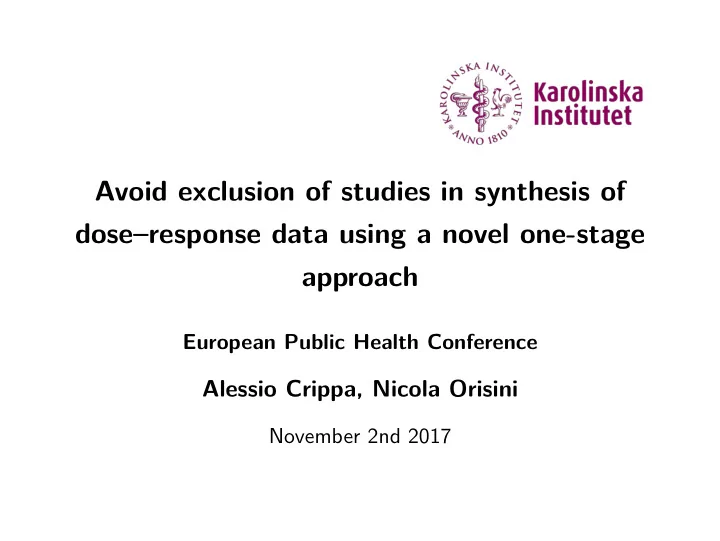

Avoid exclusion of studies in synthesis of dose–response data using a novel one-stage approach European Public Health Conference Alessio Crippa, Nicola Orisini November 2nd 2017
Background and Aims Methods Results Conclusions References Dose–response meta-analysis Summarize results from multiple studies on the relation between a quantitive exposure (e.g. diet or physical activity) and the occurrence of a health outcome (e.g. cancer or mortality) Research questions ◮ What is the shape of the association between the quantitative exposure and the outcome? ◮ What are the exposure values associated with the best or worst outcome? ◮ How heterogenous are the individual dose–response curves? Alessio Crippa European Public Health Conference November 2nd 2017 2
Background and Aims Methods Results Conclusions References Aggregated data id exposure category dose cases n OR (95% CI) 1 [-0.00336,3.5) 2.43 42 2260 1 (ref) 1 [3.5,7.01] 5.21 102 6136 0.89 (0.62, 1.28) 2 [-2.39,2.73) 1.70 39 651 1 (ref) 2 [2.73,7.83) 5.14 164 3962 0.68 (0.47, 0.97) 2 [7.83,12.9] 8.78 26 387 1.13 (0.68, 1.89) 3 [-2.14,1.64) 0.78 11 224 1 (ref) 3 [1.64,5.41) 3.89 99 2639 0.75 (0.4, 1.43) Alessio Crippa European Public Health Conference November 2nd 2017 3
Background and Aims Methods Results Conclusions References Common practice in statistical analysis Two-stage analysis: 1 Define and estimate a common dose-response model in each i − th study: y i = X β i + ε i 2 Combine study-specific β i using meta-analysis. To investigate non-linear functions, studies with less than 3 exposure categories are excluded. Alessio Crippa European Public Health Conference November 2nd 2017 4
Background and Aims Methods Results Conclusions References Aims ◮ Develop a one-stage method to avoid exlcusion of studies. ◮ Describe the new methodology and compare with a two-stage analysis. ◮ Implement the one-stage approach in most common statistical software. Alessio Crippa European Public Health Conference November 2nd 2017 5
Background and Aims Methods Results Conclusions References One stage approach A one-stage model for meta-analysis of aggregated dose-response data can be written in the general form of a linear mixed model y i = X i β + Z i b i + ǫ i (1) y i vector of non-referent log RRs in the i -th study X i contains the assigned doses (and/or transformations) ◮ Model without intercept ◮ Cov ( ε i ) = Σ i can be approximated Alessio Crippa European Public Health Conference November 2nd 2017 6
Background and Aims Methods Results Conclusions References Main features The mixed-models theory offers a good framework for several specific aspects ◮ inferential procedures (test if is there any dose-response association) ◮ predictions (predict the mean and individual curves) ◮ model comparison (which model best fits the data?) ◮ goodness-of-fit assessment (is there any evidence of lack of fit?) Alessio Crippa European Public Health Conference November 2nd 2017 7
Background and Aims Methods Results Conclusions References Comparison 1.7 Curve Odds ratio One−stage True Two−stage 1.0 0.7 0.0 2.5 5.0 7.5 10.0 Dose Alessio Crippa European Public Health Conference November 2nd 2017 8
Background and Aims Methods Results Conclusions References BLUP Study ID 1 Study ID 2 2.0 2.0 Odds Ratio Odds Ratio 1.0 1.0 0.6 0.6 0.0 2.5 5.0 7.5 10.0 0.0 2.5 5.0 7.5 10.0 Dose Dose Study ID 4 Study ID 5 Odds Ratio Odds Ratio 2.0 2.0 1.0 1.0 0.6 0.6 0.0 2.5 5.0 7.5 10.0 0.0 2.5 5.0 7.5 10.0 Dose Dose Curve One−stage True Two−stage Alessio Crippa European Public Health Conference November 2nd 2017 9
Background and Aims Methods Results Conclusions References Conclusions ◮ We introduced a one-stage approach for dose–response meta-analysis. ◮ It avoides exclusion of valuable data. ◮ It facilitates many aspects of a dose–response mete-analysis ◮ We have implented in the dosresmeta R package and in the drmeta Stata command. Alessio Crippa European Public Health Conference November 2nd 2017 10
Background and Aims Methods Results Conclusions References References ◮ Greenland S, Longnecker MP (1992). Methods for trend estimation from summarized dose– response data, with applications to meta-analysis. American Journal of Epidemiology, 135(11): 1301–1309. ◮ Orsini N, Li R, Wolk A, Khudyakov P, Spiegelman D (2012). Meta–analysis for linear and nonlinear dose–response relations: examples, an evaluation of approximations, and software. American journal of epidemiology, 175(1):66–73. ◮ Crippa A, Orsini N (2016). Multivariate dose–response meta-analysis: the dosresmeta R package. Journal of Statistical Software, Code Snippets, 72(1), 1-15. doi:10.18637/jss.v072.c01 ◮ Discacciati A, Crippa A, Orsini N (2015). Goodness of fit tools for dose–response meta-analysis of binary outcomes. Research synthesis methods. Alessio Crippa European Public Health Conference November 2nd 2017 11
Recommend
More recommend